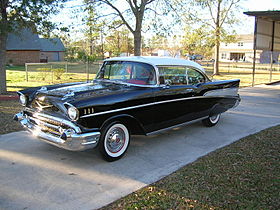1957 Chevrolet
| 1957 Chevrolet | |
|---|---|

1957 Chevrolet Bel Air Sport Coupé
|
|
| Overview | |
| Manufacturer | Chevrolet (General Motors) |
| Production | 1956–1957 |
| Designer | Clare R. Mackichan (1954) |
| Body and chassis | |
| Body style | 2-door sedan 2-door hardtop 4-door sedan 4-door hardtop 2-door convertible 2-door station wagon 4-door station wagon 2-door sedan delivery |
| Powertrain | |
| Engine | 235.5 cu in (3,859 cc) Blue Flame I6 265 cu in (4,340 cc) V8 283 cu in (4,640 cc) V8 |
| Transmission | 3-speed manual Powerglide auto Turboglide auto |
The 1957 Chevrolet is a car which was introduced by Chevrolet in September 1956 for the 1957 model year. It was available in three series models: the upscale Bel Air, the mid-range Two-Ten, and the One-Fifty. A two-door station wagon, the Nomad was produced as a Bel Air model. An upscale trim option called the "Delray" was available for two-ten 2-door sedans. It is a popular and sought after classic car. These vehicles are often restored to their original condition and sometimes modified. The car's image has been frequently used in toys, graphics, music, movies and television. The '57 Chevy, as it is often known, is an auto icon.
Initially, General Motors executives wanted an entirely new car for 1957, but production delays necessitated the 1955–56 design for one more year. Ed Cole, chief engineer for Chevrolet, dictated a series of changes that significantly increased the cost of the car. These changes included a new dashboard, sealed cowl, and the relocation of air ducts to the headlight pods, which resulted in the distinctive chrome headlight that helped make the '57 Chevrolet a classic. Fourteen-inch wheels replaced the fifteen-inch wheels from previous years to give the car a lower stance, and a wide grille was used to give the car a wider look from the front. The now famous '57 Chevrolet tailfins were designed to duplicate the wide look in the rear. Bel Air models were given gold trim: the grille, front fender chevrons, hood, and trunk script were all rendered in anodized gold. The 1957 Chevrolets did not have an oil pressure gauge or a voltmeter. The base engine was an inline 6-cylinder called the Blue Flame Six. The engine was smoother running than the V-8. Carburetion came from a single one-barrel carburetor.
The 1955 model year Chevrolet introduced its now-famous small-block V-8 — the first V-8 available in a Chevrolet since 1918. It has a displacement of 265 cu in (4,340 cc). Prior to 1955, Chevrolet offered an inline 235 cu in (3,850 cc) displacement in-line 6-cylinder engine only. The 1955 model, like its engine, was all new. The "shoebox" design, so named because it was the first Chevrolet to feature streamlined rear fenders, was a watershed for Chevrolet. The lightweight car, coupled with a powerful overhead valve V-8, became a showroom draw, but also thrust the company into the arena of competitive motorsports. 1955 Chevrolets went on to dominate drag racing and became a formidable force in circle track racing. In 1956, the design was lengthened somewhat in front and given a more squarish treatment; under the hood, engine power increased and a Chevrolet Corvette engine was available for the first time in a full-size passenger car. The V-shaped trim on the tail fins was filled with a ribbed aluminum insert exclusive to the Bel Air. The fuel-injected engine represented the first time that an internal combustion gasoline engine in a passenger car reached an advertised one horsepower for each cubic inch benchmark, although the Chrysler 300B beat that by a year in their 355-horsepower, 354 c.i.d dual-carburetored engine, and the Alfa Romeo Giulietta Sprint was introduced a year earlier than that (1954), with a 79 cubic inch (1290cc) engine that produced 80 hp. In NASCAR racing the 283 with its increased horsepower gave the '57 a dramatic advantage over the smaller 265 V8 the '55 and '56 had. NASCAR held the competition, especially the '55–'57 Chevrolet to a cubic inch restriction because of all the races the '57s were winning. This restriction stayed with the '55–'57 till they were grandfathered out of the lower NASCAR divisions in the 1970s as the '57 was still beating virtually all in their class.
...
Wikipedia
